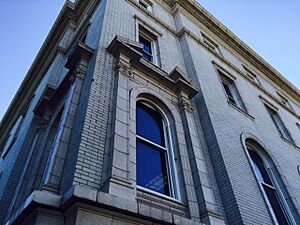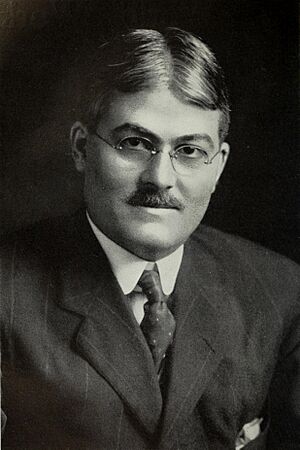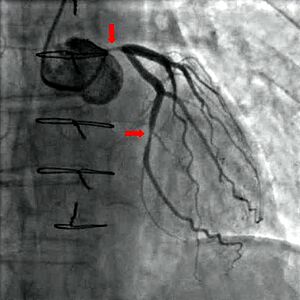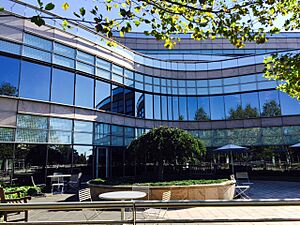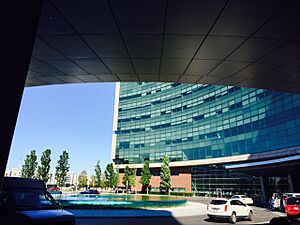History of Cleveland Clinic facts for kids
The Cleveland Clinic started in 1921. It was a special kind of medical practice where doctors worked together as a team. They had their own hospital in Cleveland, Ohio, in the United States.
Contents
How It All Began
The Idea Starts
The Cleveland Clinic's story began during World War I. A group of doctors and nurses from Cleveland's Lakeside Hospital volunteered to help. They formed a medical unit called the Lakeside Unit. Dr. George W. Crile, a top surgeon, led this group.
They helped injured soldiers during the war. Dr. Crile and his partners, Dr. Frank E. Bunts and Dr. William E. Lower, really liked how doctors worked together as a team in the military. Dr. Lower later said he admired the "teamwork and efficient organization" of military medicine.
After the war, these three doctors wanted to create a similar team-based practice in Cleveland. They asked another Cleveland doctor, Dr. John Philips, to join them. Dr. Philips was a specialist in internal medicine and children's health. He was also a veteran of the Army medical service. Together, these four doctors founded the Cleveland Clinic on February 5, 1921.
Before the war, Dr. Crile, Dr. Bunts, and Dr. Lower already worked together as surgeons. They bought a medical practice in 1891 and later moved to a new building downtown. When they decided to start the Cleveland Clinic, some people didn't like the idea of a big group medical practice. But the founders were very respected doctors in Cleveland. They were professors and leaders in the local medical community. This helped them make their dream of the Clinic come true.
First Few Years
The four founders bought land in Cleveland and built a four-story building. It had rooms for patients who didn't need to stay overnight (outpatient clinics) and for those who did (inpatient hospitalization). It also had a medical laboratory. The building opened on February 26, 1921. A famous doctor, William James Mayo, from the Mayo Clinic, spoke at the opening.
On February 28, 1921, the Cleveland Clinic welcomed its first patients, seeing 42 people. By April 1921, the Clinic had 60 employees. This included 14 doctors, four nurses, and many other staff members.
To help more patients, the Clinic bought four nearby houses in 1922. These were used for patient stays, treatments, and offices. One house was even for patients with diabetes getting insulin. In 1924, they built a larger hospital with 184 beds. They also added a power plant, laundry, and ice plant. A research lab was built in 1928.
A Difficult Time and Recovery
On May 15, 1929, a tragic event happened. X-ray films stored in the basement caught fire. This caused an explosion and sent a cloud of toxic gas through the building. Many people were injured or lost their lives, including 43 Clinic employees and co-founder Dr. John Philips. Many died trying to save patients.
Even after many investigations, no single cause for the fire was found. The Clinic's own study suggested it might have been from heat, a discarded cigarette, or contact with an electrical cord.
After the fire, a kind person named Samuel Mather helped the Clinic. He formed a group of community leaders to help the Clinic reopen in temporary buildings across the street. Amazingly, patient care started again just five days later. The original 1921 building was completely fixed up. A new three-story clinic building was added in 1931. By 1941, all the money owed for repairs was paid back.
Growing and Specializing
Who Led the Clinic
In 1941, Dr. Crile and Dr. Lower stepped down from their leadership roles. During World War II, in 1942, the Cleveland Clinic's Naval Reserve Unit helped set up a hospital in New Zealand. Dr. George Crile, Jr., the son of one of the founders, was part of this unit.
Since 1954, the Cleveland Clinic has been led by a Board of Governors made up of doctors. These doctors are chosen by the other doctors on staff. They work with the CEO and other leaders to make decisions. Here are some of the people who have led the Board of Governors:
- Fay Lefevre, MD, 1954–1968
- Carle E. Wasmuth, MD, 1968–1973
- William S. Kiser, MD, 1973–1989
- Floyd D. Loop, MD, 1989–2004
- Delos M. Cosgrove, MD, 2004–2017
- Tomislav "Tom" Mihaljevic, MD, 2018–present
Expanding Facilities
The Cleveland Clinic kept growing. In the early 1970s, they built new operating rooms for heart surgeries. An education building opened in 1964. A new hospital building, now home to Cleveland Clinic Children's, opened in 1966. A new research building was built in 1974.
In 1980, a building for pathology and lab medicine was constructed. In the late 1970s, Dr. Kiser led a plan to handle more patients. This led to a group of buildings called the Century Project, finished in 1985. It included a 14-story outpatient building designed by architect Cesar Pelli.
Becoming a Bigger System
In 1989, Dr. Loop became the leader. In the late 1990s, the Cleveland Clinic joined with nine other hospitals in the region. These included Marymount Hospital, Lakewood Hospital, and Fairview Hospital. Later, Medina Hospital joined in 2009, and Akron General Hospital became a partner in 2015.
To make healthcare easier to reach, the Cleveland Clinic also started building Family Health and Service Centers. There are now 18 of these centers across the region. They offer regular doctor visits, special medical services, and outpatient surgeries.
Between 1998 and 2004, the Cleveland Clinic added many new programs and buildings. These included the Sherwin Research Building, Children's Hospital, and the Surgery Center. They also built the Intercontinental Hotel and a conference center. During this time, the Clinic invested in an electronic medical records system. This system connects all its locations. Cleveland Clinic Florida, which started in 1988, opened a medical campus in Weston, Florida, with a hospital and emergency room.
In 1997, Dr. Loop started a fundraising campaign. A large gift from the Norma and Al Lerner family helped raise $191 million. This money was used to build the Lerner Research Institute, Cole Eye Institute, and Taussig Cancer Center. Another gift from the Lerner family helped start the Cleveland Clinic Lerner College of Medicine in 2004. A new Center for Genomics Research was finished in 2004, along with a new parking garage. In 2001, Dr. Loop announced plans for a new building for heart and vascular services. Fundraising for this project continued after he retired in 2004.


